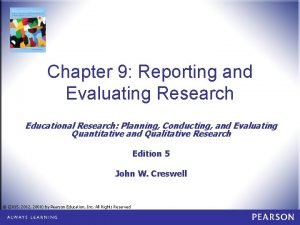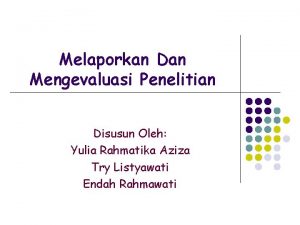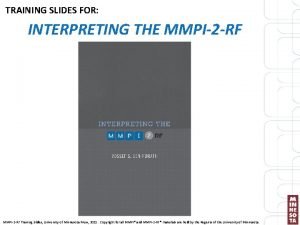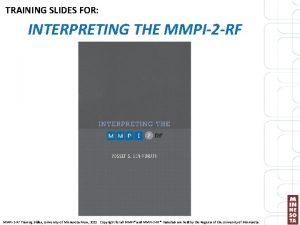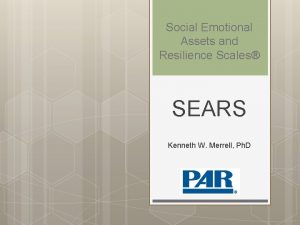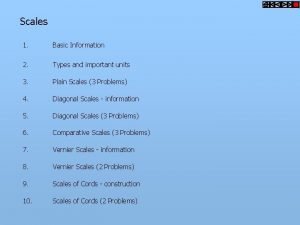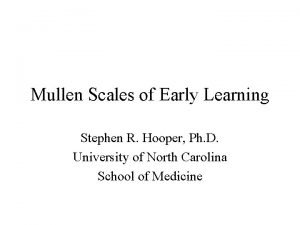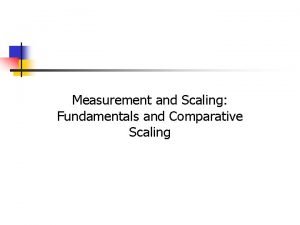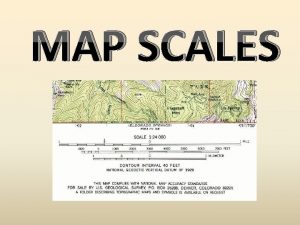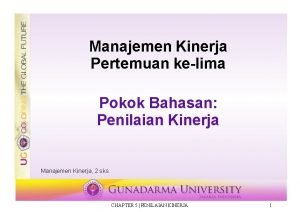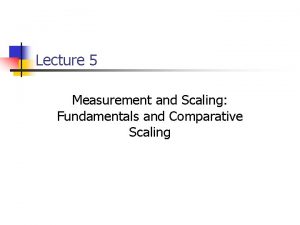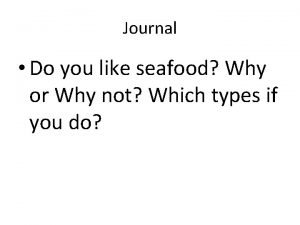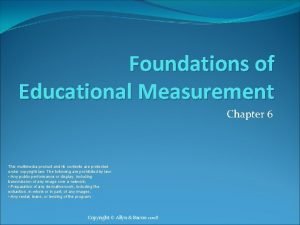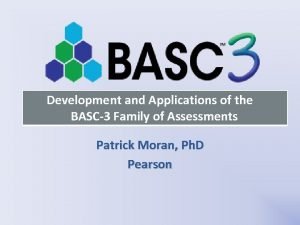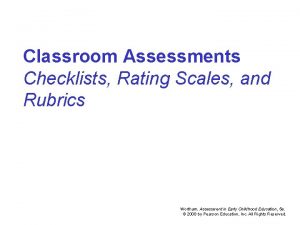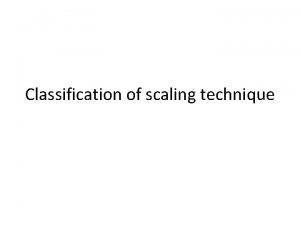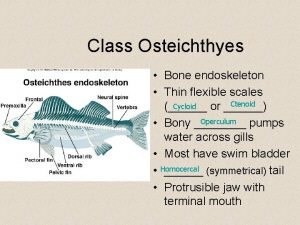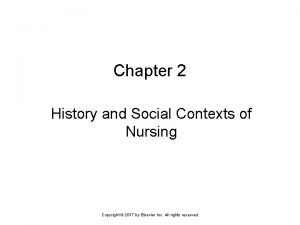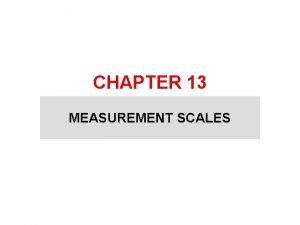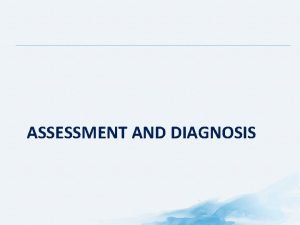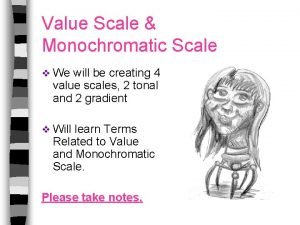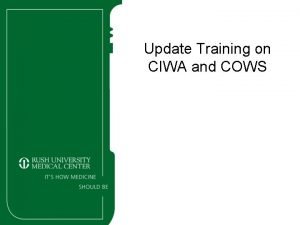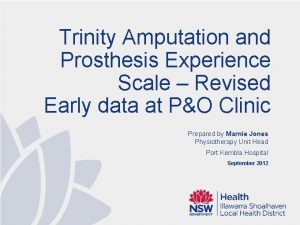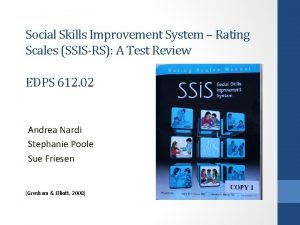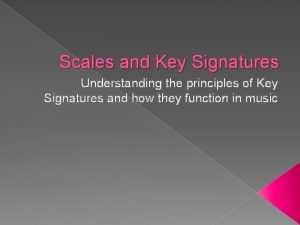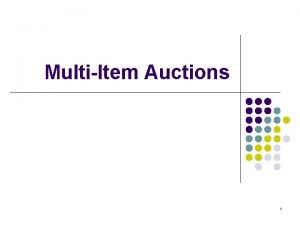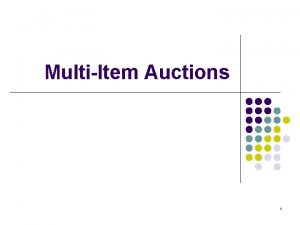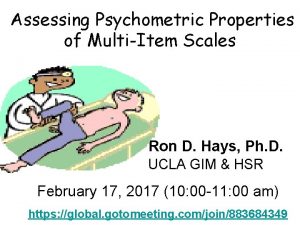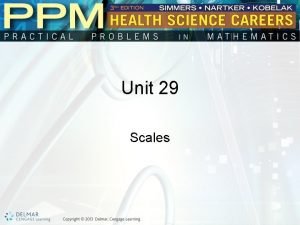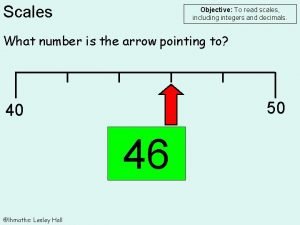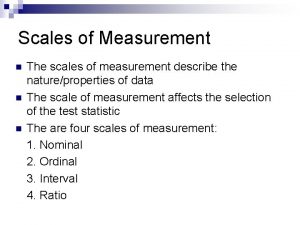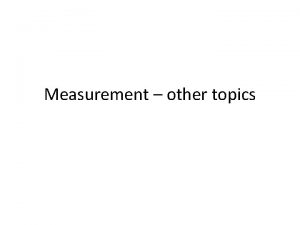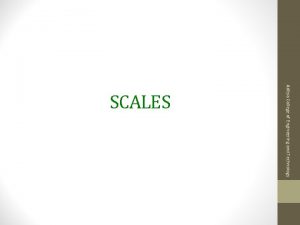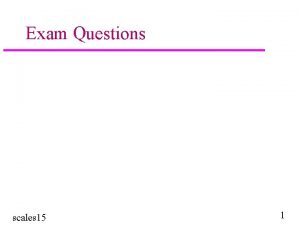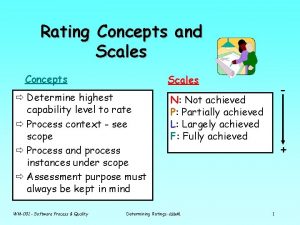Evaluating MultiItem Scales Health Services Research Design HS



















































![In the past 7 days … I was grouchy [1 st question] – – In the past 7 days … I was grouchy [1 st question] – –](https://slidetodoc.com/presentation_image_h2/90fb68bddbc2d4f6bf6580f7ccf06795/image-52.jpg)

![In the past 7 days … I felt angry [3 rd question] – – In the past 7 days … I felt angry [3 rd question] – –](https://slidetodoc.com/presentation_image_h2/90fb68bddbc2d4f6bf6580f7ccf06795/image-54.jpg)

![In the past 7 days … I felt annoyed [5 th question] – – In the past 7 days … I felt annoyed [5 th question] – –](https://slidetodoc.com/presentation_image_h2/90fb68bddbc2d4f6bf6580f7ccf06795/image-56.jpg)



- Slides: 59

Evaluating Multi-Item Scales Health Services Research Design (HS 225 B) January 26, 2015, 1: 00 -3: 00 pm 71 -257 CHS

Listed below are a few statements about your relationships with others. How much is each statement TRUE or FALSE for you 1. I am always courteous even to people who are disagreeable. Definitely Mostly Don’t Mostly Definitely True Know False 1 2 3 4 5 2. There have been occasions when I took advantage of someone. 1 2 3 4 5 3. I sometimes try to get even rather than forgive and forget. 1 2 3 4 5 4. I sometimes feel resentful when I don’t get my way. 1 2 3 4 5 5. No matter who I’m talking to, I’m always a good listener. 1 2 3 4 5 2

Scoring Multi-Item Scales • Average or sum all items in the same scale. • Transform average or sum to • 0 (worse) to 100 (best) possible range • z-score (mean = 0, SD = 1) • T-score (mean = 50, SD = 10) 3

Linear Transformations X ZX Y = (original score - minimum) *100 (maximum - minimum) (X - X) = SDX = target mean + (target SD * Zx) 4

Listed below are a few statements about your relationships with others. How much is each statement TRUE or FALSE for you 1. I am always courteous even to people who are disagreeable. Definitely Mostly Don’t Mostly Definitely True Know False 100 75 50 25 0 2. There have been occasions when I took advantage of someone. 0 25 50 75 100 3. I sometimes try to get even rather than forgive and forget. 0 25 50 75 100 4. I sometimes feel resentful when I don’t get my way. 0 25 50 75 100 5. No matter who I’m talking to, I’m always a good listener. 100 75 50 25 0 5

Create T-score z-score = (score – 36)/31 T-score = (10 * z-score) + 50 z-score = (100 - 36)/31 = 2. 06 T-score = 71

Aspects of Good Measures Aside from being practical. . 1. Same people get same scores 2. Different people get different scores and differ in the way you expect 3. Measure is interpretable 4. Measure works the same way for different groups (age, gender, race/ethnicity) 7

Aspects of Good Measures Aside from being practical. . 1. Same people get same scores 2. Different people get different scores and differ in the way you expect 3. Measure is interpretable 4. Measure works the same way for different groups (age, gender, race/ethnicity) 8

Aspects of Good Measures Aside from being practical. . 1. Same people get same scores 2. Different people get different scores and differ in the way you expect 3. Measure is interpretable 4. Measure works the same way for different groups (age, gender, race/ethnicity) 9

Aspects of Good Measures Aside from being practical. . 1. Same people get same scores 2. Different people get different scores and differ in the way you expect 3. Measure is interpretable 4. Measure works the same way for different groups (age, gender, race/ethnicity) 10

Aspects of Good Measures Aside from being practical. . 1. Same people get same scores 2. Different people get different scores and differ in the way you expect 3. Measure is interpretable 4. Measure works the same way for different groups (age, gender, race/ethnicity) 11

Reliability Degree to which the same score is obtained when the target or thing being measured (person, plant or whatever) hasn’t changed. ü Inter-rater (rater) üNeed 2 or more raters of the thing being measured ü Internal consistency (items) üNeed 2 or more items ü Test-retest (administrations) üNeed 2 or more time points 12

Ratings of Performance of Six HPM 225 B Lectures by Two Raters [1 = Poor; 2 = Fair; 3 = Good; 4 = Very good; 5 = Excellent] 1= Marjorie Kagawa-Singer (Good, Very Good) 2= Tom Belin (Very Good, Excellent) 3= Rick Dees (Good, Good) 4= Ron Hays (Fair, Poor) 5= Jack Needleman (Excellent, Very Good) 6= Jane Error (Fair, Fair) (Target = 6 presenters; assessed by 2 raters) 13

Reliability Formulas Model Reliability Intraclass Correlation Two-way random Twoway mixed Oneway BMS = Between Ratee Mean Square N = n of ratees WMS = Within Mean Square k = n of items or raters JMS = Item or Rater Mean Square EMS = Ratee x Item (Rater) Mean Square 14

01 13 01 24 02 14 02 25 03 13 03 23 04 12 04 21 05 15 05 24 06 12 06 22 Two-Way Random Effects (Reliability of Ratings of Presentations) Source Presenters (BMS) Raters (JMS) Pres. x Raters (EMS) Total df SS MS 5 15. 67 0. 00 2. 00 3. 13 0. 00 0. 40 11 17. 67 = 0. 89 2 -way R = 6 (3. 13 - 0. 40) 6 (3. 13) + 0. 00 - 0. 40 ICC = 0. 80 15

Responses of Presenters to Two Questions about Their Health 1= Marjorie Kagawa-Singer (Good, Very Good) 2= Tom Belin (Very Good, Excellent) 3= Rick Dees (Good, Good) 4= Ron Hays (Fair, Poor) 5= Jack Needleman (Excellent, Very Good) 6= Jane Error (Fair, Fair) (Target = 6 presenters; assessed by 2 items) 16

01 34 02 45 03 33 04 21 05 54 06 22 Two-Way Mixed Effects (Cronbach’s Alpha) Source df Presenters (BMS) Items (JMS) Pres. x Items (EMS) Total Alpha = 5 1 5 SS 15. 67 0. 00 2. 00 11 MS 3. 13 0. 00 0. 40 17. 67 3. 13 - 0. 40 = 2. 93 = 0. 87 3. 13 ICC = 0. 77 17

Reliability Minimum Standards • 0. 70 or above (for group comparisons) • 0. 90 or higher (for individual assessment) Ø SEM = SD (1 - reliability)1/2 Ø 95% CI = true score +/- 1. 96 x SEM Ø if z-score = 0, then CI: -. 62 to +. 62 when reliability = 0. 90 Ø Width of CI is 1. 24 z-score units 18

Cross-Tab of Ratings P Rater 2 P F 0 Rater 1 F G VG 1 1 1 VG 1 E 0 E 1 1 G Total 2 2 1 0 1 1 1 6

Calculating KAPPA PC = Pobs. = Kappa = (0 x 1) + (2 x 1) + (1 x 2) + (1 x 1) (6 x 6) 2 6 = 0. 33– 0. 19 1 - 0. 19 = 0. 17 = 0. 19

Weighted Kappa Linear (Quadratic) P F G VG E P 1 . 75 (. 937) . 50 (. 750) . 25 (. 437) 0 F . 75 (. 937) 1 . 75 (. 937) . 50 (. 750) . 25 (. 437) G . 50 (. 750) . 75 (. 937) 1 . 75 (. 937) . 50 (. 750) VG . 25 (. 437) . 50 (. 750) . 75 (. 937) 1 . 75 (. 937) 0 . 25 (. 437) . 5 (. 750) . 75 (. 937) 1 E Wl = 1 – ( i/ (k – 1)) W q = 1 – (i 2 / (k – 1) 2) i = number of categories ratings differ by k = n of categories

All Kappas PC = Pobs. = Kappa = (0 x 1) + (2 x 1) + (1 x 2) + (1 x 1) (6 x 6) 2 6 = 0. 33– 0. 19 1 - 0. 19 = 0. 17 Linear weighted kappa = 0. 52 Quadratic weighted kappa = 0. 77 = 0. 19

Guidelines for Interpreting Kappa Conclusion Kappa Poor Fair <. 40 Poor < 0. 0 . 40 -. 59 Slight . 00 -. 20 Good . 60 -. 74 Fair . 21 -. 40 >. 74 Moderate . 41 -. 60 Substantial . 61 -. 80 Almost perfect . 81 - 1. 00 Excellent Fleiss (1981) Landis and Koch (1977) 23

Item-scale correlation matrix 24

Item-scale correlation matrix 25

Confirmatory Factor Analysis 26

Confirmatory Factor Analysis Fit Indices • Normed fit index: 2 null - 2 model 2 null 2 2 null df null • Non-normed fit index: - model df model null 2 df null • Comparative fit index: 1 - RMSEA = SQRT (λ 2 – df)/SQRT (df (N – 1)) 2 model 2 - df null - dfnull - 1 model

Validity Does scale represent what it is supposed to be measuring? • Content validity: Does measure “appear” to reflect what it is intended to (expert judges or patient judgments)? – Do items operationalize concept? – Do items cover all aspects of concept? – Does scale name represent item content? • Construct validity – Are the associations of the measure with other variables consistent with hypotheses? 28

Relative Validity Example Sensitivity of measure to important (clinical) difference Severity of Kidney Disease None Mild Severe F-ratio Relative Validity Burden of Disease #1 87 90 91 2 -- Burden of Disease #2 74 78 88 10 5 Burden of Disease #3 77 87 95 20 10 29

Evaluating Construct Validity Scale (Better) Physical Functioning Age (years) (-) 30

Evaluating Construct Validity Scale (Better) Physical Functioning Age (years) Medium (-) 31

Evaluating Construct Validity Scale (Better) Physical Functioning Age (years) Medium (-) Effect size (ES) = D/SD D = Score difference SD = SD Small (0. 20), medium (0. 50), large (0. 80) 32

Evaluating Construct Validity Scale (Better) Physical Functioning Age (years) Medium (-) r ˜ 0. 24 Cohen effect size rules of thumb (d = 0. 20, 0. 50, and 0. 80): Small r = 0. 100; medium r = 0. 243; large r = 0. 371 r = d / [(d 2 + 4). 5] = 0. 80 / [(0. 802 + 4). 5] = 0. 80 / [(0. 64 + 4). 5] = 0. 80 / [( 4. 64). 5] = 0. 80 / 2. 154 = 0. 371 33

Evaluating Construct Validity Scale Age (years) Obese yes = 1, no = 0 (Better) Physical Functioning Medium (-) Small (-) Kidney Disease In Nursing home yes = 1, no = 0 Large (-) Cohen effect size rules of thumb (d = 0. 20, 0. 50, and 0. 80): Small r = 0. 100; medium r = 0. 243; large r = 0. 371 r = d / [(d 2 + 4). 5] = 0. 80 / [(0. 802 + 4). 5] = 0. 80 / [(0. 64 + 4). 5] = 0. 80 / [( 4. 64). 5] = 0. 80 / 2. 154 = 0. 371 34

Evaluating Construct Validity Scale Age (years) Obese yes = 1, no = 0 Kidney Disease In Nursing home yes = 1, no = 0 (Better) Physical Functioning Medium (-) Small (-) Large (-) (More) Depressive Symptoms (? ) Small (+) Cohen effect size rules of thumb (d = 0. 20, 0. 50, and 0. 80): Small r = 0. 100; medium r = 0. 243; large r = 0. 371 r = d / [(d 2 + 4). 5] = 0. 80 / [(0. 802 + 4). 5] = 0. 80 / [(0. 64 + 4). 5] = 0. 80 / [( 4. 64). 5] = 0. 80 / 2. 154 = 0. 371 (r’s of 0. 10, 0. 30 and 0. 50 are often cited as small, medium, and large. ) 35

Questions? 36

Responsiveness to Change • Measures should be responsive to interventions that change the underlying construct • Need external indicators of change (Anchors) – Clinical measure • “improved” group = 100% reduction in seizure frequency • “unchanged” group = <50% change in seizure frequency – Retrospective self- or provider-report of change • Much better, A little better, Same, A little worse, Much worse • Anchor correlated with change on target measure at 0. 371 or higher 37

Responsiveness Index Effect size (ES) = D/SD D = raw score change in “changed” (improved) group SD = baseline SD • Small: 0. 20 ->0. 49 • Medium: 0. 50 ->0. 79 • Large: 0. 80 or above 38

Responsiveness Indices (1) Effect size (ES) = D/SD (2) Standardized Response Mean (SRM) = D/SD† (3) Guyatt responsiveness statistic (RS) = D/SD‡ D = raw score change in “changed” group; SD = baseline SD; SD† = SD of D; SD‡ = SD of D among “unchanged” 39

Amount of Expected Change Varies SF-36 physical function score mean = 87 (SD = 20) Assume I have a score of 100 at baseline v Hit by Bike causes me to be – limited a lot in vigorous activities – limited a lot in climbing several flights of stairs – limited a little in moderate activities SF-36 physical functioning score drops to 75 (-1. 25 SD) v Hit by Rock causes me to be – limited a little in vigorous activities SF-36 physical functioning score drops to 95 (- 0. 25 SD) 40

Partition Change on Anchor ØA lot better ØA little better ØNo change ØA little worse ØA lot worse 41

Use Multiple Anchors • 693 RA clinical trial participants evaluated at baseline and 6 weeks post-treatment. • Five anchors: 1. 2. 3. 4. 5. Self-report (global) by patient Self-report (global) by physician Self-report of pain Joint swelling (clinical) Joint tenderness (clinical) Kosinski, M. et al. (2000). Determining minimally important changes in generic and diseasespecific health-related quality of life questionnaires in clinical trials of rheumatoid arthritis. Arthritis and Rheumatism, 43, 1478 -1487. 42

Patient and Physician Global Reports How are you (is the patient) doing, considering all the ways that RA affects you (him/her)? • • Very good (asymptomatic and no limitation of normal activities) Good (mild symptoms and no limitation of normal activities) Fair (moderate symptoms and limitation of normal activities) Poor (severe symptoms and inability to carry out most normal activities) • Very poor (very severe symptoms that are intolerable and inability to carry out normal activities --> Improvement of 1 level over time 43

Global Pain, Joint Swelling and Tenderness • 0 = no pain, 10 = severe pain • Number of swollen and tender joints -> 1 -20% improvement over time 44

Effect Sizes for SF-36 Physical Function Change Linked to Minimal Change in Anchors Scale Physical Function Self-R Clin. -R. 35 . 33 Pain Swell Tender Mean . 34 . 26 . 32 45

Effect Sizes for SF-36 Changes Linked to Minimal Change in Anchors Scale Self-R PF Role-P . 35. 56 Pain GH . 83. 20 EWB Role-E . 39. 41 SF EF . 43. 50 PCS MCS . 49. 42 46

Effect Sizes (mean = 0. 34) for SF-36 Changes Linked to Minimal Change in Anchors Scale Self-R Clin. -R Pain Swell Tender Mean PF Role-P . 35. 56 . 33. 52 . 34. 29 . 26. 35 . 32. 36 . 32. 42 Pain GH . 83. 20 . 70. 12 . 47. 09 . 69. 12 . 42. 04 . 62. 12 EWB Role-E . 39. 41 . 26. 28 . 25. 18. 38 . 05. 26 . 23. 30 SF EF . 43. 50 . 34. 47 . 28. 22 . 29. 22 . 38. 35 . 34. 35 PCS MCS . 49. 42 . 48. 27 . 34. 19 . 29. 27 . 36. 20 . 39. 27 47

Item Response Theory (IRT) IRT models the relationship between a person’s response Yi to the question (i) and his or her level of the latent construct being measured by positing bik estimates how difficult it is to get a score of k or more on item (i). ai is an estimate of the discriminatory power of the item.

Item Responses and Trait Levels Person 1 Item 1 Person 2 Person 3 Item 2 www. nihpromis. org Item 3 Trait Continuum

Computer Adaptive Testing (CAT)

Reliability Target for Use of Measures with Individuals § Reliability ranges from 0 -1 § 0. 90 or above is goal ØSEM = SD (1 - reliability)1/2 Ø 95% CI = true score +/- 1. 96 x SEM Ø if true z-score = 0, then CI: -. 62 to +. 62 Ø Width of CI is 1. 24 z-score units • Reliability = 0. 90 when SE = 3. 2 – T-scores (mean = 50, SD = 10) – Reliability = 1 – (SE/10)2 T = 50 + (z * 10)
![In the past 7 days I was grouchy 1 st question In the past 7 days … I was grouchy [1 st question] – –](https://slidetodoc.com/presentation_image_h2/90fb68bddbc2d4f6bf6580f7ccf06795/image-52.jpg)
In the past 7 days … I was grouchy [1 st question] – – – Never Rarely Sometimes Often Always Estimated Anger = 56. 1 SE = 5. 7 (rel. = 0. 68) [39] [48] [56] [64] [72]

In the past 7 days … I felt like I was ready to explode [2 nd question] – – – Never Rarely Sometimes Often Always Estimated Anger = 51. 9 SE = 4. 8 (rel. = 0. 77)
![In the past 7 days I felt angry 3 rd question In the past 7 days … I felt angry [3 rd question] – –](https://slidetodoc.com/presentation_image_h2/90fb68bddbc2d4f6bf6580f7ccf06795/image-54.jpg)
In the past 7 days … I felt angry [3 rd question] – – – Never Rarely Sometimes Often Always Estimated Anger = 50. 5 SE = 3. 9 (rel. = 0. 85)

In the past 7 days … I felt angrier than I thought I should [4 th question] - Never – – Rarely Sometimes Often Always Estimated Anger = 48. 8 SE = 3. 6 (rel. = 0. 87)
![In the past 7 days I felt annoyed 5 th question In the past 7 days … I felt annoyed [5 th question] – –](https://slidetodoc.com/presentation_image_h2/90fb68bddbc2d4f6bf6580f7ccf06795/image-56.jpg)
In the past 7 days … I felt annoyed [5 th question] – – – Never Rarely Sometimes Often Always Estimated Anger = 50. 1 SE = 3. 2 (rel. = 0. 90)

In the past 7 days … I made myself angry about something just by thinking about it. [6 th question] – – – Never Rarely Sometimes Often Always Estimated Anger = 50. 2 SE = 2. 8 (rel = 0. 92)

PROMIS Physical Functioning vs. “Legacy” Measures 10 20 30 40 50 60 70

Thank you. Powerpoint file is freely available at: http: //gim. med. ucla. edu/Faculty. Pages/Hays/ Contact information: drhays@ucla. edu 310 -794 -2294
 Marketing research measurement scales
Marketing research measurement scales Types of measurement in research
Types of measurement in research Primary scales of measurement in marketing research
Primary scales of measurement in marketing research Reporting and evaluating research
Reporting and evaluating research Reporting and evaluating research
Reporting and evaluating research Research design vs research method
Research design vs research method Appendix example in research
Appendix example in research Methodology errors
Methodology errors Exploratory research types
Exploratory research types Nature of qualitative research
Nature of qualitative research Diffserv vs intserv
Diffserv vs intserv Wake county human services community services center
Wake county human services community services center Mmpi scales
Mmpi scales Clinical scales of mmpi
Clinical scales of mmpi Sears rating scale
Sears rating scale 4 types of scales
4 types of scales Reynolds intellectual screening test
Reynolds intellectual screening test Pressure units
Pressure units Graphic rating scales
Graphic rating scales Mullen scales
Mullen scales Formality scale in sociolinguistics
Formality scale in sociolinguistics What are the 4 measurement scales?
What are the 4 measurement scales? Scale of measurement
Scale of measurement Floor plan grade 10 maths literacy
Floor plan grade 10 maths literacy Maps and scales grade 12
Maps and scales grade 12 What is the definition of map scale
What is the definition of map scale Behavioral observation scales adalah
Behavioral observation scales adalah Scales in physics
Scales in physics Scales of measurement
Scales of measurement Covered by firm shell and have segmented body
Covered by firm shell and have segmented body Types of scales in educational measurement
Types of scales in educational measurement Branching gills
Branching gills Kinds of fish and shellfish for processing
Kinds of fish and shellfish for processing Cycloid scales
Cycloid scales Basc 3 classification ranges
Basc 3 classification ranges Rating scales and rubrics
Rating scales and rubrics Classification of scaling
Classification of scaling Bony endoskeleton
Bony endoskeleton Chondrichthyes characteristics
Chondrichthyes characteristics Chondrichthyes scales
Chondrichthyes scales Scale scores convey more information than index scores.
Scale scores convey more information than index scores. Jessie sleet scales
Jessie sleet scales All vertebrates
All vertebrates Sales force evaluation
Sales force evaluation Nominal scale
Nominal scale Bars rating scale
Bars rating scale Behaviorally anchored rating scales
Behaviorally anchored rating scales Engineering drawing format
Engineering drawing format Pqrst pain
Pqrst pain Brown add scales
Brown add scales Wechsler adult and children scales - fsiq - mean 100 sd 15
Wechsler adult and children scales - fsiq - mean 100 sd 15 Monochromatic scales
Monochromatic scales Cows scale
Cows scale Trinity amputation and prosthesis experience scales
Trinity amputation and prosthesis experience scales Truck scales
Truck scales Griffiths mental development scales
Griffiths mental development scales Striped bass scales
Striped bass scales Ssis age range
Ssis age range Shekel scales
Shekel scales Do not use key signature
Do not use key signature



